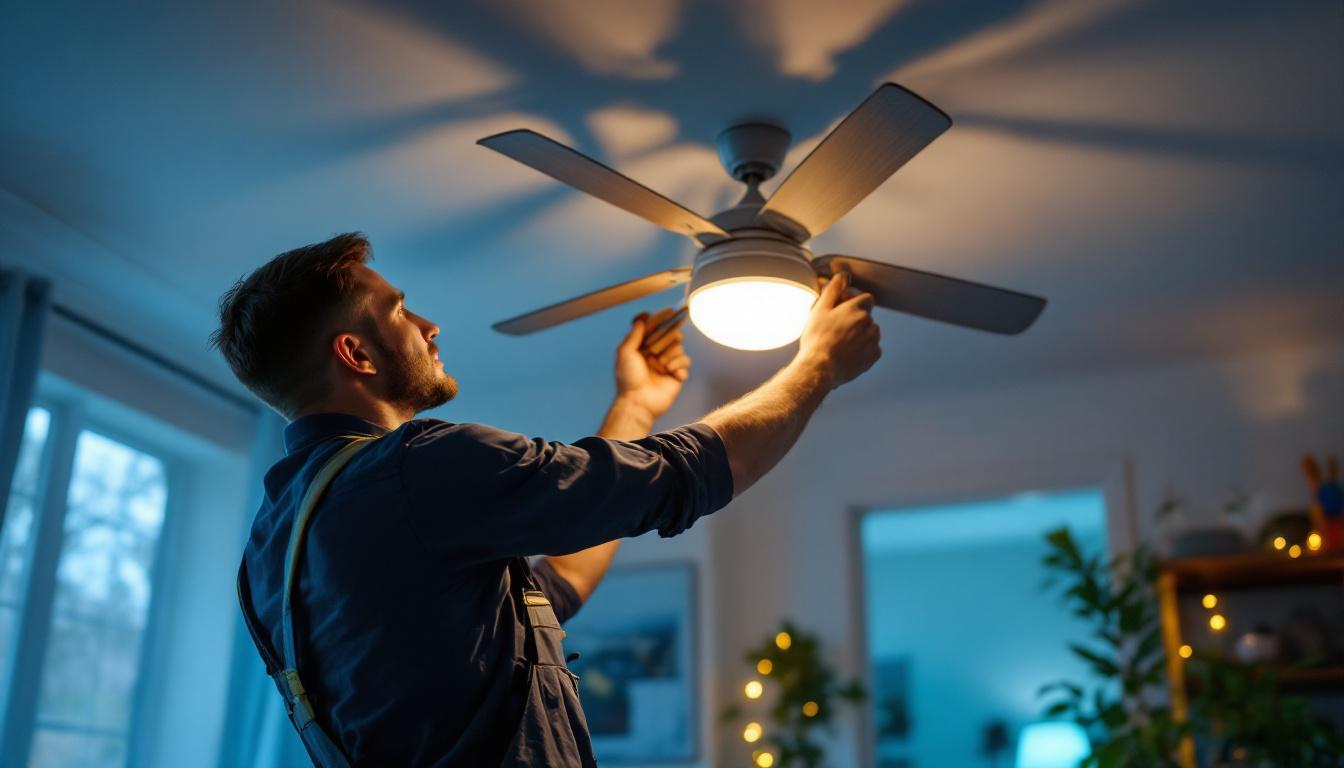
In the world of lighting and electrical installations, ceiling fans are often an overlooked yet essential component. They not only provide comfort but also enhance the aesthetic appeal of a space. For lighting contractors, understanding the intricacies of ceiling fan outlets is crucial for delivering quality service and ensuring customer satisfaction. This handbook aims to equip contractors with the knowledge and skills necessary to navigate the complexities of ceiling fan outlets.
Ceiling fan outlets are specialized electrical boxes designed to support the weight and movement of ceiling fans. Unlike standard light fixtures, ceiling fans require more robust support due to their size and operational dynamics. This section delves into the specifics of ceiling fan outlets, including their design, installation requirements, and safety considerations.
Ceiling fan outlets must be designed to accommodate the unique demands of ceiling fans. This includes ensuring that the outlet box is rated for fan support, typically requiring a minimum load capacity of 70 pounds. Additionally, the box should be securely mounted to a structural element, such as a ceiling joist, to prevent any risk of failure.
Contractors should also be aware of the different types of outlet boxes available. Options include standard metal or plastic boxes and more specialized fan-rated boxes that incorporate additional support features. Understanding these specifications is essential for selecting the right outlet for each installation. Moreover, the design of the outlet box can also influence the aesthetic appeal of the ceiling fan. Some boxes come with decorative covers that can blend seamlessly with the ceiling, enhancing the overall look of the room while maintaining functionality.
Proper installation of ceiling fan outlets is paramount to ensure safety and functionality. Contractors must follow the National Electrical Code (NEC) guidelines, which stipulate that fan-rated boxes must be installed in a way that can withstand the fan’s weight and motion. This often involves using specific mounting brackets or hardware designed for ceiling fans.
Furthermore, it’s important to consider the wiring involved. Ceiling fans typically require a dedicated circuit or a switch that can control both the fan and the light fixture. Ensuring that the wiring is correctly configured will prevent potential issues and enhance the longevity of the installation. Additionally, many modern ceiling fans come equipped with remote control capabilities, which necessitates careful attention to the wiring setup to accommodate these features. This can include integrating smart home technology, allowing homeowners to control their ceiling fans via smartphone apps or voice commands, adding a layer of convenience and modernity to the installation.
Safety should always be a top priority when working with electrical installations. Ceiling fan outlets must be installed in compliance with local building codes and safety regulations. This includes using appropriate materials and ensuring that all connections are secure and insulated. Regular inspections and maintenance checks are also recommended to identify any wear or potential hazards.
Contractors should educate their clients on the importance of safety as well. Providing guidance on how to operate the fan safely and what to look for in case of malfunction can help prevent accidents and ensure a positive experience for the homeowner. Additionally, discussing the signs of wear, such as unusual noises or wobbling during operation, can empower homeowners to take proactive measures. Encouraging clients to schedule periodic professional inspections can also help maintain the integrity of the ceiling fan and its outlet, ensuring that both remain in optimal working condition for years to come. This proactive approach not only enhances safety but also extends the lifespan of the ceiling fan installation, providing lasting comfort and style to the living space.
The selection of the right ceiling fan is as crucial as the installation of the outlet itself. Factors such as size, style, and functionality must be considered to ensure that the fan meets the needs of the space while complementing the overall design. This section explores how to guide clients in selecting the perfect ceiling fan.
One of the most critical factors in selecting a ceiling fan is its size. A fan that is too small will not effectively circulate air, while one that is too large can overwhelm a room’s proportions. As a rule of thumb, the diameter of the fan should correspond to the room’s size. For instance, a fan with a 52-inch blade span is typically suitable for rooms measuring 225 to 400 square feet.
Contractors should also consider the height of the ceiling. For rooms with high ceilings, it may be necessary to use a downrod to lower the fan to an optimal height for airflow. Educating clients on these considerations can enhance their satisfaction with the final result.
Ceiling fans come in a wide variety of styles, from modern and sleek designs to traditional and ornate options. The choice of style should align with the overall decor of the room. For instance, a contemporary fan may look out of place in a rustic setting. Contractors should encourage clients to consider both functionality and aesthetics when selecting a fan.
Additionally, color and finish play a significant role in the fan’s visual impact. Options range from classic white or black finishes to more unique colors and textures. Providing clients with samples or visual aids can help them make informed decisions that they will be happy with for years to come.
Modern ceiling fans often come equipped with various features that enhance their functionality. These may include remote controls, integrated lighting, and smart home compatibility. Educating clients about these features can help them choose a fan that not only meets their aesthetic preferences but also fits their lifestyle needs.
For instance, a fan with a remote control may be ideal for a large living room where reaching the pull chain may be inconvenient. Similarly, a fan that integrates with smart home systems can provide added convenience and energy efficiency. Contractors should stay informed about the latest trends and technologies in ceiling fans to provide clients with the best options available.
Understanding the electrical wiring involved in ceiling fan installations is crucial for lighting contractors. Proper wiring ensures that the fan operates safely and efficiently. This section outlines the essential wiring considerations for ceiling fans, including circuit requirements and wiring techniques.
Ceiling fans typically require a dedicated circuit, especially if they include integrated lighting. This is to prevent overloading the circuit, which can lead to tripped breakers or, worse, electrical fires. Contractors should assess the existing electrical system to determine if a dedicated circuit is necessary and advise clients accordingly.
In cases where a dedicated circuit is not feasible, using a switch that controls both the fan and light can be an alternative. However, it is essential to ensure that the circuit can handle the combined load of both fixtures without exceeding safety limits.
Correct wiring techniques are vital for the safe operation of ceiling fans. This includes using the appropriate gauge wire, typically 14 or 12-gauge, depending on the circuit’s amperage. Additionally, ensuring that all connections are secure and properly insulated is crucial to prevent shorts or electrical failures.
Contractors should also educate clients on the importance of professional installation. While some homeowners may attempt to install ceiling fans themselves, improper wiring can lead to dangerous situations. Emphasizing the value of hiring a qualified contractor can help clients understand the importance of safety in electrical work.
Once a ceiling fan is installed, ongoing maintenance is essential to ensure its longevity and performance. This section provides guidance on routine maintenance tasks and troubleshooting common issues that may arise with ceiling fans.
Regular maintenance can significantly extend the life of a ceiling fan. Contractors should recommend that clients clean the fan blades periodically to prevent dust buildup, which can affect performance and air quality. Using a damp cloth or a specialized fan blade cleaner can help keep the blades in optimal condition.
Additionally, checking the fan’s mounting hardware and electrical connections at least once a year is advisable. Loose screws or connections can lead to wobbling or even detachment of the fan from the ceiling, posing safety risks. Encouraging clients to schedule annual maintenance checks can help prevent these issues.
Even with proper maintenance, issues may arise with ceiling fans. Common problems include wobbling, noise, and failure to operate. Contractors should be prepared to troubleshoot these issues effectively. For instance, wobbling may often be resolved by ensuring that the fan blades are balanced and securely attached.
Noisy fans can often be remedied by tightening loose screws or lubricating the motor. If a fan fails to operate, checking the circuit breaker and ensuring that the wiring is intact are essential first steps. Providing clients with a basic troubleshooting guide can empower them to address minor issues without needing immediate professional assistance.
Ceiling fan outlets play a pivotal role in the successful installation and operation of ceiling fans. By understanding the design, installation requirements, and safety considerations, lighting contractors can ensure that they provide high-quality service to their clients. Additionally, guiding clients in selecting the right ceiling fan and educating them about maintenance and troubleshooting can enhance customer satisfaction and loyalty.
As the demand for ceiling fans continues to grow, staying informed about the latest trends, technologies, and best practices will position contractors as trusted experts in the field. This handbook serves as a comprehensive resource for lighting contractors, empowering them to excel in their craft and deliver exceptional results in every ceiling fan installation.
Ready to elevate your lighting projects with the highest quality ceiling fan outlets and accessories? Look no further than LumenWholesale, where we provide contractors with spec-grade lighting products at unbeatable wholesale prices. Our extensive selection is designed to meet the highest industry standards, ensuring you get reliable, high-performance lighting for every installation. Plus, with free shipping on bulk orders, you can stock up on all your ceiling fan needs without worrying about hidden fees or compromises. Don’t miss out on the perfect blend of quality, affordability, and convenience. Discover the best value in wholesale lighting by visiting Wholesale Lighting at the Best Value today.

Discover the essential guide for lighting contractors with our comprehensive handbook on lamp post poles.

Discover how lounge lighting ceiling solutions can transform your lighting installation projects.

Discover the essential guide to 4 recessed LED can lights tailored for lighting contractors.

Discover the science behind yard pole lights and enhance your expertise as a lighting contractor.